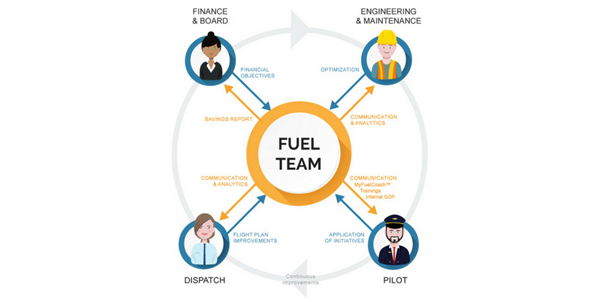[Decarbonizing Aviation] Episode 9: Operational improvements
If you want to learn more about the opportunities and challenges of aviation decarbonization, you've come to the right place!
|
This mini-series of small articles will present you successively:
This ninth article looks at a sum of initiatives or fuel-saving best practices that can significantly improve the fuel efficiency of an airline’s operations, reduce its carbon footprint, and at the same time improve its bottom line by alleviating its #1 operating cost. |
Operational improvements
Operational improvements are measures that airlines can implement to execute their operations more efficiently without modifying their fleet or infrastructures.
Based on benchmarks it has conducted since 2004 on more than 100 airlines, IATA estimates that these operational measures can reduce the airline’s fuel budget by 2-6% for airlines that already have a structured fuel efficiency program in place, and up to 14% for airlines with no such program in place[1].
These operational measures are described in publications such as IATA Guidance Material and Best Practices for Fuel and Environmental Management, Airbus series of Getting to Grips with Fuel Economy, or Boeing Aero magazine. The most recent publication on the matter is OpenAirlines’ Green Airlines Fuel Book[2], free to download.
A company-wide commitment
These operational improvements can be implemented throughout almost all airline departments: flight ops, dispatch, engineering and maintenance, or commercial and ground operations.
Representatives from all departments should be integrated into a fuel team[3] that drives the adoption of fuel-saving best practices.
The following figure describes a subset of these fuel-saving best practices per department.
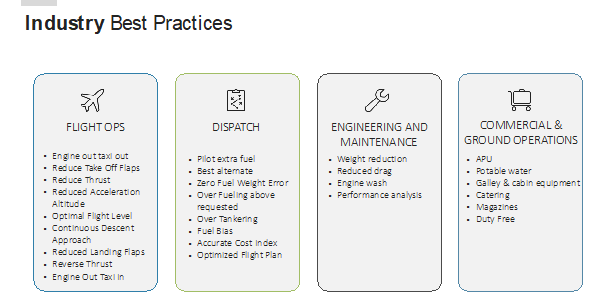
Flight Ops
Flight Ops best practices concern all phases of a flight.
Shutting down one engine during taxi is a safe and widespread best practice to save fuel. In just 5 minutes of single-engine taxi, a B777 will save 65kg of fuel[4].
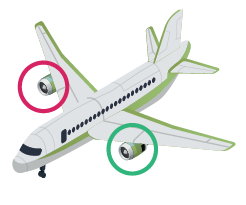
When noise abatement procedures allow it, accelerating earlier during climb can save 200kg on each B777 flight[5].
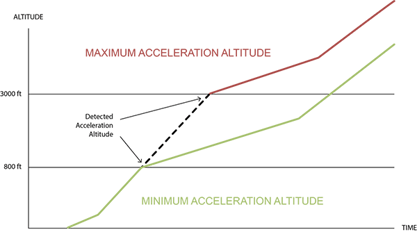
If a pilot can perform a CDA (Continuous Descent Approach) during the descent, he/she will save between 30 to 70kg of fuel on an A320 or B737.
As Captain Andriy Kostyuk explained it at the Aircraft Commerce Conference in 2017 in London, Ukraine International Airlines is saving 28kg per landing on the Embraer E190 by applying visual approaches in Kyiv when VMC conditions allow it[6].
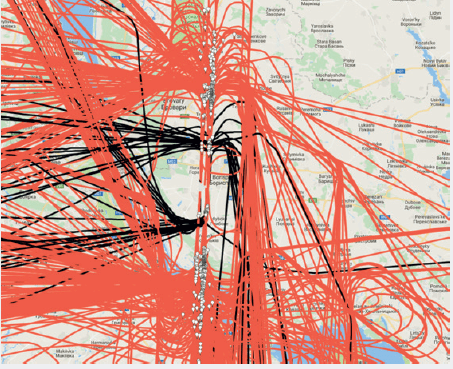
Figure 1: Black lines highlight performed visual approaches that can save 28 kg per landing on the E190.
And these are just some flight ops fuel-saving best practices among dozens of others.
Dispatch
Dispatch best practices look at trajectory analysis, fuel reserves, or flying at optimal speed.
They all contribute to improving the flight plan for 1) safety and comfort, 2) on-time performance, and 3) fuel efficiency.
With advanced data analytics, modern fuel management information systems such as SkyBreathe create a feedback loop between actual observations recorded daily and flight planning.
This feedback loop allows dispatchers to select the best SID or STAR based on weather and expected congestion by the time of day or day of the week. They allow for planning just the right amount of fuel for tax: if an airline that operates 50 A320 incorrectly plans 20% of extra taxi fuel on each flight (which is not much), it will waste more than 200,000 kg of kerosene in a whole year[7].
Flight plan accuracy also plays a significant role in pilot trust and reduces pilot extra fuel[8].

Figure 2: Just a few months after the introduction of SkyBreathe, Norwegian could increase its flight planning accuracy and increase pilot trust. This quickly led to a reduction of pilot extra fuel.
Selecting the right speed and striking the right balance between the cost of fuel (flying slower burns less fuel) and the cost of time (flying longer increases maintenance and crew costs) is the idea behind the concept of Cost Index. A cost reduction of 1-3% is a realistic expectation with a properly design cost index program[9].

Source: Boeing
Engineering and Maintenance
Engineering and Maintenance best practices can focus on weight reduction, engine wash, or aircraft performance monitoring.
A high-pressure engine wash on a B737 can improve fuel consumption by 80 kg/hour, as shown in this diagram.

Figure 3: Engine performance tracked by SkyBreathe
Each extra ton carried on a ten-hour flight will require an additional 350 kg of fuel or 1 ton of CO2. Replacing passenger seats, trolleys, or cargo containers with lighter material can pay off quickly.
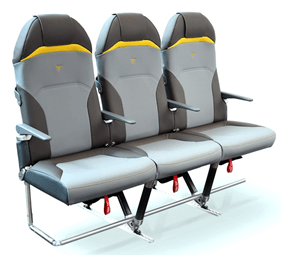
Expliseat is developing ultra-light seats using carbon fiber and Titanium[10].
At the Aircraft Commerce Conference in October 2018 in Bangkok, Arief Rachman, Senior Manager, Head of Scheduling Department at Citilink Indonesia, explained how removing one oven from the cabin resulted in saving 20kg of fuel per flight due to weight reduction[11].
Commercial and ground operations
Even commercial and ground operations can have a significant impact on aircraft consumption. According to United Continental, an APU (Auxiliary Power Unit) uses 150 to 400+kg of fuel per hour while Ground Power Units (GPU) provided by the airport use less than 20 kg of fuel per hour[12].
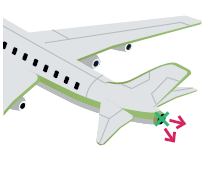
Citilink reduced potable water quantity on shorter flights and saved 2 tons of fuel per year. Dowload our case study "Driving fuel efficiency at Citilink" >>
Digital tools
Forward-looking airlines have embraced the digital revolution and have adopted based on Big Data (modern aircraft records gigabytes of information on each flight) and Artificial Intelligence. They leverage the gigabytes of data that modern aircraft generate, ATC data, and weather data to provide recommendations to airlines specific to their network, fleet, and operations.
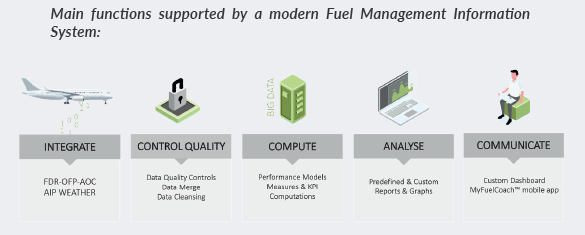
Figure 4: SkyBreathe integrates all the relevant data from the airlines and provide detailed recommentations to all stakeholders to save fuel
Pilots are trained to perform Green Operating Procedures; they use dedicated briefing and debriefing apps that act as a virtual coach to help them fly greener.
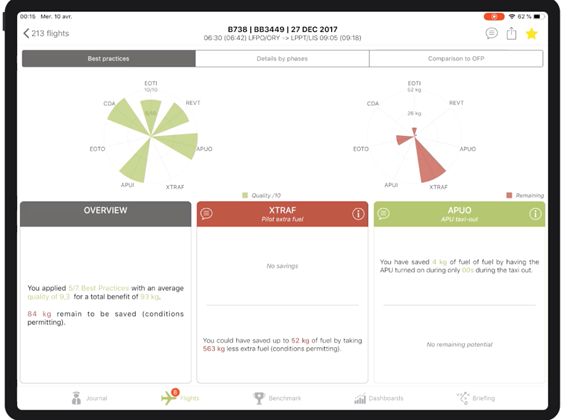
Figure 5 : The MyFuelCoach app provides a complete eco-debrief after each flight.
This diagram from Cebu Pacific shows how introducing such an app to their pilots drastically increased the application rate of various fuel-saving best practices.
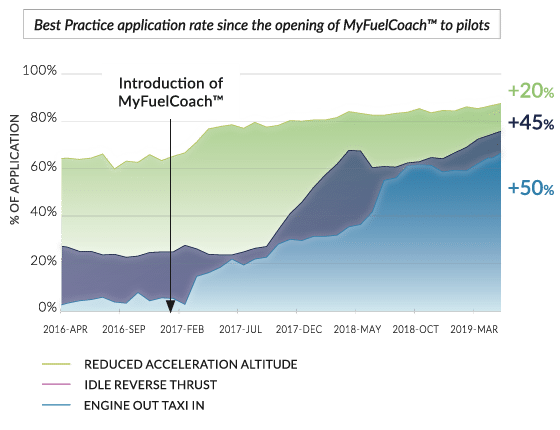
Airlines have recently adopted eco-flying apps running on EFBs (Electronic Flight Blag). Leveraging avionics data in real-time through an AID (Aircraft Interface Device), they provide contextualized guidance to the pilots with direct recommendations or taxi assistance.
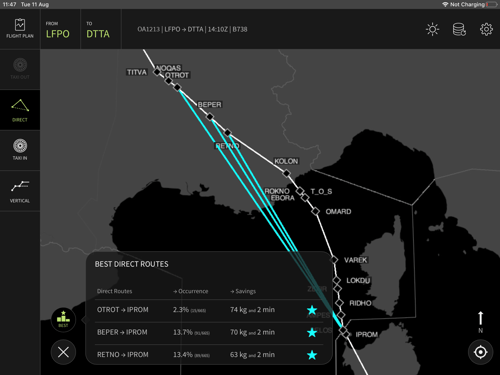
Figure 6: Direct recommendations by SkyBreathe OnBoard.SkyBreathe OnBoard is an EFB application that provides real-time support for fuel-saving during the flight
What’s up in the next episode?
In the next episode, we’ll look at other operational improvements. Instead of focusing on the aircraft operators, we will take a look at the Air Traffic Management system and how ATC improvements can yield another 10% in CO2 reduction.
References
[1] https://www.iata.org/contentassets/100e39327f164f63924f8b2bc371e260/cons-sfo-fuel-efficiency-prog-brochure.pdf
[2]https://blog.openairlines.com/the-green-airlines-fuel-book
[3] https://blog.openairlines.com/how-to-set-up-an-efficient-fuel-team
[4 ]https://blog.openairlines.com/engine-out-taxi-in-eoti
[5] https://blog.openairlines.com/what-you-need-to-know-about-reduced-acceleration-altitude
[6] https://blog.openairlines.com/case-study-fuel-management-uia
[7] https://blog.openairlines.com/compute-optimized-taxi-fuel
[8] https://blog.openairlines.com/how-to-reduce-pilot-extra-fuel
[9] https://blog.openairlines.com/top-10-facts-or-myths-about-cost-index
[10] https://www.expliseat.com/products-seat-lines/
[11] https://blog.openairlines.com/how-to-use-the-cost-of-weight-to-be-more-fuel-efficient
[12] https://blog.openairlines.com/how-to-track-apu-fuel-burn-on-ground
WANT TO LEARN MORE?
Discover airline's fuel-saving tips & best practices in The Green Airlines Fuel Book



